Getting your smart home network right is key, but it takes some thought. This guide will show you how to get the most out of your smart home WiFi. It’s all about picking the best system and setting up your network to fit your needs. You’ll learn everything you need for a safe and smart home life.
If you love smart home tech, you know a good WiFi setup is essential. This guide is perfect if you’re new to smart homes or if you’re upgrading. With this advice, your home will be smarter and more convenient.1
Key Takeaways
- Understand the major smart home ecosystems and choose the one that aligns with your device preferences and needs.
- Ensure your home WiFi network is reliable and capable of supporting a growing number of smart home devices.
- Properly configure your network settings to optimize performance and enhance security for your smart home devices.
- Leverage smart hubs and wireless technologies to improve the connectivity and responsiveness of your smart home setup.
- Prioritize privacy and security measures to protect your personal information and prevent unauthorized access to your smart home network.
Choosing the Right Smart Home Ecosystem
Setting up a smart home begins with picking the right system for you. You have three big choices: Google Home, Amazon Alexa, and Apple HomeKit.1 Google Home is perfect if you use Android.1 Amazon Alexa fits with the most products.1 And Apple HomeKit is super secure for iPhone owners, though a bit picky about which devices it works with.2
Google Home: Seamless Integration with Android
For Android lovers, Google Home is the way to go. It connects smoothly and works easily. Plus, the Google Assistant is all about making your life easier with smart, talkative responses.
Amazon Alexa: Widest Range of Compatible Products
Alexa is known for working with tons of devices.1 It lets you link up different things in your home with ease. From lights to security, Alexa has you covered.
Apple HomeKit: Secure and Intuitive for iPhone Users
If you’re all about iPhone, Apple HomeKit has your back.1 It keeps your personal info safe and gives you smooth control.2 Because it’s from Apple, it plays very well with iOS.
To find your best fit, look at what each choice offers.2 Think about your current devices, the assistant you like, and what you want your smart home to do.
The Importance of a Reliable Wi-Fi Network
A stable, fast reliable home wifi network is key for a smart home to work well. It’s important to know the difference between 2.4GHz and 5GHz wifi frequency. Also, issues like too many devices using the wifi and router limits must be dealt with for the best experience.3
Understanding Wi-Fi Frequencies: 2.4GHz vs. 5GHz
2.4GHz wifi travels further, which is good for devices far from the router. On the other hand, 5GHz is faster but can have problems with nearby signals.3
Addressing Wi-Fi Congestion and Router Limitations
The more devices you connect, the slower your wifi might be. This is known as wifi congestion. To fix this, you might need a new router. This can help all your smart devices work better without any wifi dead spots.4

| Feature | 2.4GHz Wi-Fi | 5GHz Wi-Fi |
|---|---|---|
| Range | Longer | Shorter |
| Speed | Slower | Faster |
| Interference | Less susceptible | More susceptible |
Connecting Smart Home Devices
Linking your smart devices to the network has different ways. You can use Bluetooth, Wi-Fi, or smart hubs.5 Bluetooth is slow and sometimes not reliable.6 Wi-Fi offers better stability, but some smart devices may have trouble connecting on the 2.4-GHz band.
Bluetooth vs. Wi-Fi vs. Smart Hubs
Smart hubs, like Philips Hue bridge or Samsung SmartThings, can help. They reduce network crowding and make your devices react quicker.6 Hubs can connect using many wireless methods, becoming the main link for your smart home.
Integrating Smart Hubs for Better Performance
Adding smart hubs makes your smart home run smoother. Hubs manage how devices talk to each other. This helps even when the internet is down.6 Some routers have a special network for devices that need the 2.4-GHz band but can still talk to the main network.6
Choosing between Bluetooth, Wi-Fi, or smart hubs depends on your setup. Think about what each can do and how it fits with your devices.6 Knowing about each option helps you pick the best for a smart home that works well.
Verifying Smart Home Device Compatibility
Before you buy smart home gadgets, make sure they work with your chosen smart home ecosystem. Check for the “Works with” logos. These logos show the device supports Google Assistant, Amazon Alexa, or Apple HomeKit.7 Knowing if a device is compatible will make your smart home setup smooth and efficient. All your gadgets will work together easily.7
Think about product compatibility and how well it fits into your smart home ecosystem. This makes your home network run better with fewer problems.7 Paying attention to what devices support helps your smart home work well. It makes everything more convenient.7
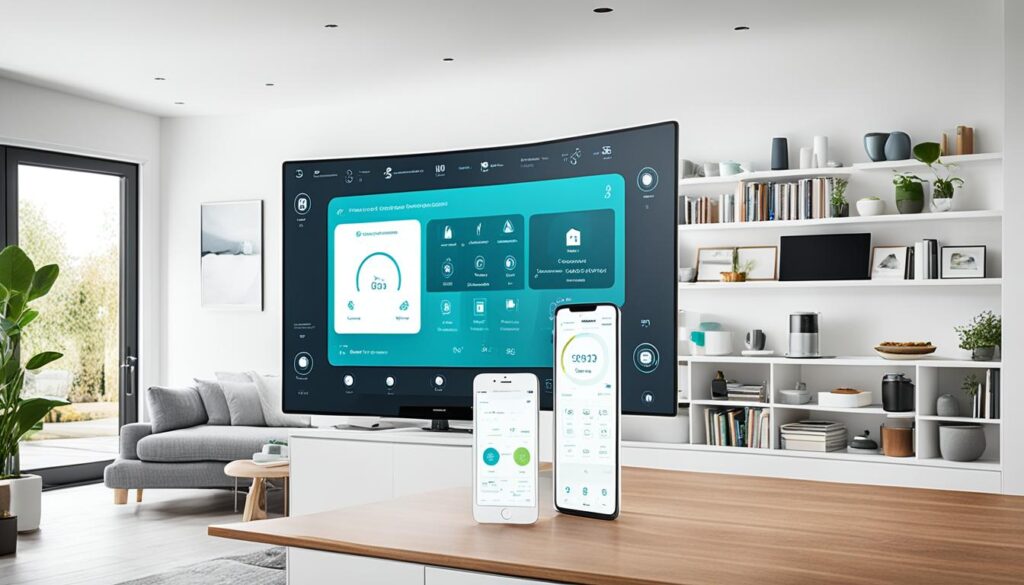
Choosing the right smart home ecosystem and checking device compatibility is key. It ensures your smart home works together without issues.7 Do this, and you’ll have a home that runs smoothly and automatically.8
| Smart Home Ecosystem | Compatibility Features |
|---|---|
| Google Home | Works great with Android, lots of devices work with it |
| Amazon Alexa | Has the most gadgets that can work with it, and popular security systems use it for voice control8 |
| Apple HomeKit | It’s secure and easy to use for iPhone fans, but fewer devices work with it |
Match your smart home devices to your chosen ecosystem. This creates an efficient and pleasant smart home. It improves your daily life.78
Understanding Smart Home Standards
As smart homes grow, knowing how devices connect is key. They use standards like Thread, Zigbee, Z-Wave, and more to talk to each other and your network.1 These standards vary in range, power use, and how easily they work together. This affects how well your smart home runs.
Thread, Zigbee, and Other Wireless Technologies
Thread is made for smart homes, offering long range, low energy use, and strong security. This makes it a top pick for many gadgets.1 Zigbee is also popular, but it might not reach as far as Thread.9 Z-Wave, meanwhile, can cover up to 30 meters, which is usually more than Zigbee’s 10 meters.9
This means some devices can work with more than one standard.1 Knowing about these standards helps you choose the best gadgets for your home. It ensures they all connect well together.
| Wireless Technology | Range | Power Consumption | Compatibility |
|---|---|---|---|
| Thread | Improved range | Low power | Widely supported by smart home hubs and devices |
| Zigbee | Up to 10 meters | Moderate power | Widely used in smart home products |
| Z-Wave | Up to 30 meters | Moderate power | Common in smart home devices |
smart home wifi setup
Setting up your smart home wifi configuration well is vital. It ensures your smart devices work smoothly.1 They often use the 2.4-GHz frequency. But, the 5-GHz is getting popular because it’s faster.1 Wi-Fi 6E is newer and better for handling more devices, uses less power, and keeps things more secure.1 Routers today can support about 250 devices. Though, they might not work perfectly with all devices at once.1 Picking a top-notch router and placing it well is crucial for strong Wi-Fi.1 And, it’s wise to use a long, mix-of-characters password for Wi-Fi safety.
Configuring Your Wi-Fi Network for Smart Home Devices
Make different networks for your smart home device connectivity, guests, and important systems.6 Most smart home gadgets connect only to the 2.4-GHz band. This is why setup may be tricky.6 On many systems, you can split the Wi-Fi bands.6 Google’s Nest WiFi has no band-splitting ability but provides a guest network at 2.4-GHz.6 Netgear routers offer an “IoT network” for 2.4-GHz devices. This keeps them apart from the main network.6 On a guest network, visitors can’t reach devices on the main network. This keeps everything safer from viruses.
Optimizing Wi-Fi Settings for Smart Home Performance
Use features like creating separate Wi-Fi networks for certain devices to boost security and avoid interference.1 Devices like Philips Hue lights can help make connections better, cut down congestion, and make devices react faster.1 There are different techs for connecting devices, like Thread and Zigbee. Using them in smart hubs is smart.1 It’s increasingly common to see smart technologies, like Thread, in devices like smart speakers.1 When buying devices or checking online, look for logos that say “Works with the Google Assistant,” “Works with Alexa,” or “Works with Apple HomeKit.” This tells you they will work in your system.
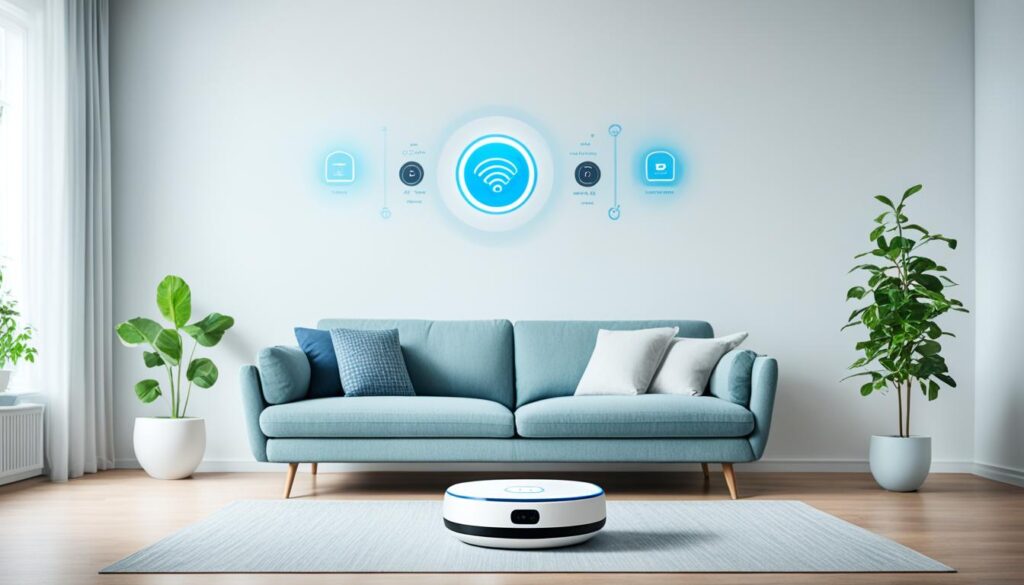
Securing Your Smart Home Network
Securing your smart home network keeps your personal data safe. Regular updates for your devices are important. Use strong, unique passwords. Also, consider wireless network segmentation. This helps keep your smart home safe from hackers. Adding a firewall and security software adds more protection too.
Updating Devices and Using Strong Passwords
Keeping devices updated prevents security risks.10 Firmware updates play a big role in keeping your smart home secure. It’s crucial to use strong, unique passwords for your devices. Don’t just stick with the default ones. This helps stop people from accessing your devices without permission.10
Enabling Wireless Network Segmentation
Creating a separate network for your IoT devices is smart.10 This means setting up a different network for these devices. It’s called wireless network segmentation. It keeps your smart home gadgets away from your main network. This lowers the chance of any security issues spreading.10
Implementing Firewalls and Security Software
Using a firewall and powerful security software adds extra protection. Features like NETGEAR Armor, powered by Bitdefender, are great for your smart home network.10 These tools can catch and stop threats. They help keep your personal info and smart devices secure.
| Security Feature | Benefit |
|---|---|
| Regular device updates | Mitigates security risks from outdated firmware10 |
| Strong, unique passwords | Prevents unauthorized access to smart home devices10 |
| Wireless network segmentation | Isolates IoT devices from the primary home network, improving security10 |
| Firewalls and security software | Provides an additional layer of protection against potential threats10 |
Smart Home Device Placement and Naming
Placing your smart home devices carefully and naming them thoughtfully can boost your home’s functionality. Put them where they can easily get power and Wi-Fi. This helps them work better and faster.1
Naming your devices is crucial too. It makes them simple to control using your voice or phone. This is especially useful when you add more devices to your setup.1
| Smart Home Device Placement Considerations | Smart Home Device Naming Recommendations |
|---|---|
|
|
Following these smart home device placement and naming tips can really improve your home. It will be smoother to use and more user-friendly.111

Automation, Routines, and Voice Commands
A smart home lets you automate tasks and use voice commands.12 With smart home routines, you make daily life easier.13 You can use devices like Google Assistant or Amazon Alexa for hands-free control. This includes managing your lights and adjusting the temperature.12
Creating Smart Home Routines for Convenience
You can start the day by setting an alarm to play the news.13 Only those with special access can set up routines that fit the whole household.13 However, everyone at home, even guests, can use these routines.13
You can set up special routines for when no one’s home or when someone returns.14 And it’s easy to stop or delete a routine if you don’t need it anymore.13 But remember, what you can do in a routine depends on your devices and any rules they have.13
Mastering Voice Commands for Hands-Free Control
Starting a routine is simple; you can use voice, time, events like sunrise, and more.13 Voice assistants like Alexa, Google, and Siri are great for this.12 By adding security cameras and smart locks, your home becomes safer. You get cool features like voice ID and controlling music in every room.12
Buying smart devices isn’t cheap at first, but it pays off with savings and an easier life.12

Moving or Changing Routers
Changing your router or moving your network is a big deal for your smart home. It’s key to make sure the switch is smooth. You need to set up your new router right, move your settings, and connect all your devices.
It’ll keep everything running perfectly in your smart home setup. When you move to a new place, your Wi-Fi address might not update right away.15 You might also need more boosters if you’re leaving some connected devices behind.
To make connecting devices easy, give your new router the same name and password as the old one. Most devices will connect automatically. But, some you might have to manually reset to join the new network.15
If the new house is laid out differently, you might need extra boosters or to move some devices around. This keeps your smart home network and devices working well.
When you’re moving a smart home hub to a new place, you have to do some special steps. For example, delete the old hub from the app, reset it, and connect it to the new router.15
With good planning, changing networks won’t mess up your smart home’s operation. It will continue to be convenient, just like before.16
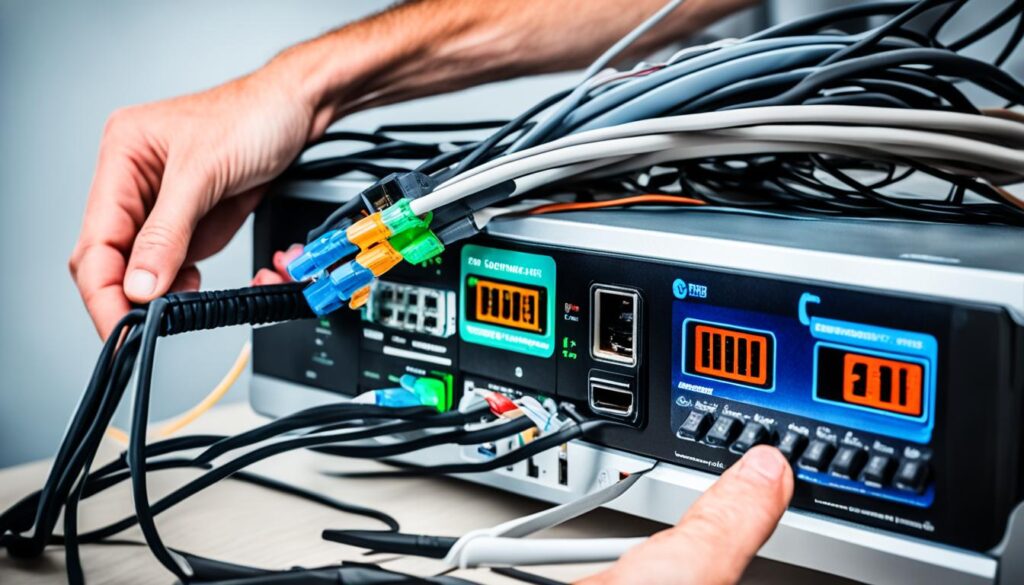
Privacy and Security Considerations
Smart home tech comes with many plus points. But, it also brings up big concerns about privacy and security. Devices like voice assistants and cameras could be used to listen in. It’s key to protect yourself by turning off microphones when you’re not using them.
Safeguarding Against Eavesdropping
To guard against eavesdropping, always know what your smart device can do. Activate privacy settings when needed. This can mean turning off microphones or cameras to keep your talks private.17
Securing Personal and Confidential Information
Keeping your personal info safe is a must. Smart home networks can be open to cyber threats. Use strong passwords and update your devices often. This will safeguard your home and data.17
| Potential Smart Home Security Risks | Recommended Security Measures |
|---|---|
| Device Vulnerabilities | |
| Network Security |
|
| Data Privacy |
|
Taking action and setting up these steps can improve your privacy and security. You’ll still enjoy living in a smart home, but safer.
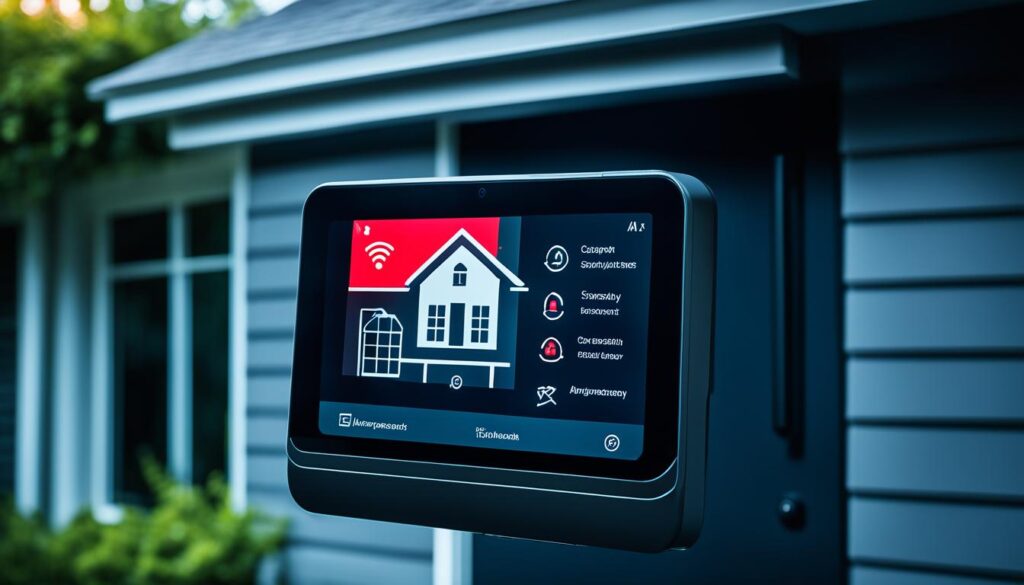
Troubleshooting Smart Home Wi-Fi Issues
Sometimes, even the smartest of smart homes face Wi-Fi troubles. These problems can disrupt your devices. Finding the cause – be it signal interference or heavy network use – is key to fixing them well.
Identifying and Resolving Wi-Fi Connectivity Problems
Your smart gadgets use different wireless tech to talk to each other and to your network.18 Mixing devices from various brands can cause hiccups. Understanding tech standards helps. So does having a smart home hub.
Keeping your Wi-Fi stable is vital for your home’s gadgets to do their job. Steps to tackle this include updating your router’s software and checking device placement. You might also think about changing to a new router or mesh network.
Common Smart Home Wi-Fi Troubleshooting Tips
Problems like false alarms on cameras can pop up for different reasons. Fixing this might need you to tweak settings or get help from an expert, especially if you’re new to smart tech.
To make your smart devices last and work well, look at their battery health and settings. Keep them close to the router. This can prevent issues like fast battery drain. New standards like Matter are also making it easier for devices from different brands to work together.
For strong support, think about a protection plan. It can help with many tech devices, offer expert help, and keep digital threats away. Tackling Wi-Fi issues and using help available ensures your smart home remains smooth, making your life easier.
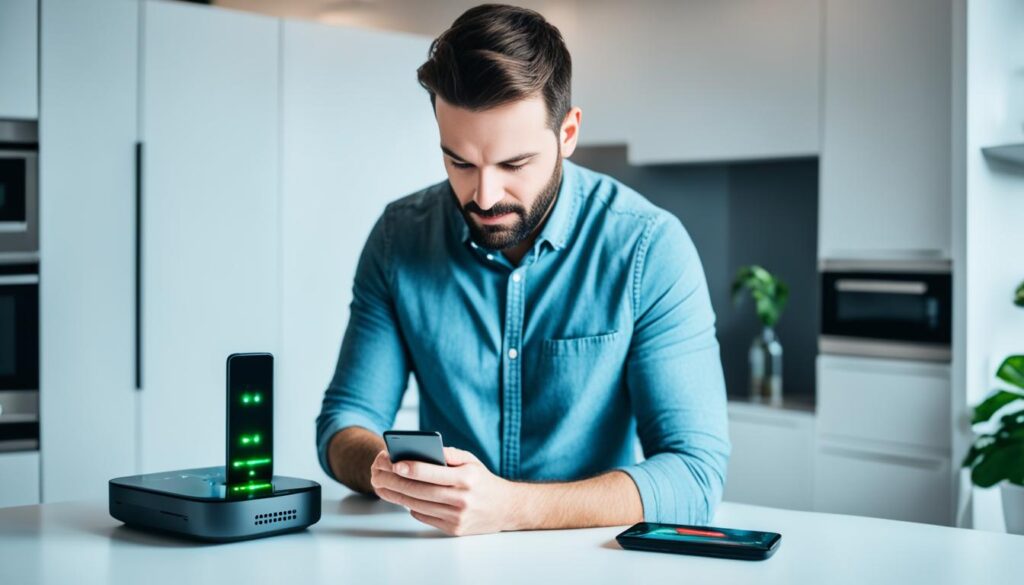
Conclusion
In conclusion, a reliable Wi-Fi network is key to a smart home. It makes living easy and seamless. This guide helps me set up my smart home right. It boosts security and lets me make the most of my devices.19 I’ve learned how to pick the best smart home tech and secure my network. With the info from this article, I’m ready to build my perfect smart home.
Smart home tech has become popular in the 21st century. It includes things like smart thermostats that save energy.20 There are many smart devices out there. It’s important to do your homework and choose the ones that fit your needs. They can make life easier for everyone and keep your home safe.20 Even though smart devices might cost more at first, they can increase your home’s value. They could also lower your insurance costs.20
Smart homes use less energy and help the planet.21 You can control your lights from far away to save even more. Smart security systems are great for keeping your home safe. They have cameras, sensors, and detectors. But, setting up smart technology can be expensive.21 Smart homes need a good internet connection. This might raise concerns about privacy and make it harder for some to use.21
This guide gives me the tools to manage smart home tech. It shows me how to set up my system the best way. With the tips here, I can make my home safer and more convenient. I can tailor it to exactly what I need and like.
FAQ
What are the major smart home platforms to consider?
The top smart home platforms include Google Home, Amazon Alexa, and Apple HomeKit. They differ in features, what they work with, and privacy options. Choose the one that fits your needs and the devices you have.
Why is a stable and high-performing Wi-Fi network important for a smart home setup?
A strong Wi-Fi network is crucial for smart homes. It ensures your devices stay connected and work well. Knowing about Wi-Fi types and how to reduce network traffic can boost your smart home’s performance.
How can I connect my smart home devices to the network?
You can link smart home gadgets with Bluetooth, Wi-Fi, or a hub. Wi-Fi is often better, while Bluetooth might be slower. Smart hubs can help make your network faster and less crowded.
How can I ensure my smart home devices are compatible with my chosen ecosystem?
Check if the devices fit your smart home system before buying. Look for logos that show they work with Google Assistant, Amazon Alexa, or Apple HomeKit. This ensures all your devices work together smoothly.
What wireless technologies are used in smart home devices, and how do they differ?
Smart home gadgets use various tech, like Thread, Zigbee, and Z-Wave. These have different ranges and battery uses. Knowing these can help you pick the right products for your home.
How can I properly configure my Wi-Fi network for optimal smart home performance?
To set up your Wi-Fi for smart homes, create different networks for various uses. Also, picking the right Wi-Fi settings is crucial. This makes sure your devices run smoothly.
What steps can I take to secure my smart home network?
Securing your smart home is key. Update your devices often and use strong passwords. Also, segmenting your Wi-Fi network adds more security. Don’t forget to have a firewall and use security software.
How can I optimize the placement and naming of my smart home devices?
Where you put and how you name your smart devices matters a lot. Place them close to power and Wi-Fi for the best connection. Clever naming makes them easier to control with your voice or app.
How can I set up smart home routines and utilize voice commands?
Start enjoying the benefits of a smart home by setting up routines. This makes your daily life easier. Learn to use voice commands with your smart assistant, like Google Assistant or Amazon Alexa, for hands-free control.
What should I consider when moving or changing my home router?
Updating your home router needs some care to keep your smart devices working. Make sure your new router is set up correctly. This avoids any problems with your smart home setup.
What privacy and security considerations should I keep in mind for my smart home?
Use your smart home devices wisely to avoid privacy risks. Be cautious of potential eavesdropping and keep your data secure from cyber threats.
How can I troubleshoot smart home Wi-Fi issues?
Even with a good smart home setup, you might face Wi-Fi problems. Find out why your devices aren’t connecting well. This guide offers tips to fix your Wi-Fi and get your devices running smoothly again.
Source Links
- https://www.wired.com/story/how-to-set-up-smart-home/
- https://www.theverge.com/23751295/smart-home-platform-google-amazon-apple-samsung
- https://consumer.ftc.gov/articles/how-secure-your-home-wi-fi-network
- https://htacertified.org/app/articles/why-enterprise-grade-network-must-every-luxury-home/
- https://smarthomesmadesimple.org/how-to-get-it/setting-up/
- https://www.wired.com/story/how-to-set-up-smart-home-on-wi-fi-band/
- https://www.linkedin.com/pulse/how-troubleshoot-smart-device-compatibility-issues-smart-home-vlbac
- https://www.adt.com/resources/smart-home-device-compatibility
- https://www.techtarget.com/iotagenda/definition/smart-home-or-building
- https://www.netgear.com/hub/technology/iot-device-security-home/
- https://support.google.com/googlenest/answer/9159862?hl=en
- https://www.hdlautomation.com/Articles_100000157677328.html
- https://support.google.com/googlenest/answer/7029585?hl=en&co=GENIE.Platform=Android
- https://support.google.com/googlenest/answer/10071816?hl=en
- https://community.smartthings.com/t/moving-home-and-taking-aeotec-smart-hub-with-me/270438
- https://www.theverge.com/23453354/keep-smart-home-devices-online-replace-wifi-router-how-to
- https://whirlocal.io/content/privacy-and-security-concerns-in-smart-homes-what-you-need-to-know/
- https://www.asurion.com/connect/tech-tips/5-most-frequent-problems-with-smart-home-tech/
- https://www.investopedia.com/terms/s/smart-home.asp
- https://ecosmarthomepros.com/pros-and-cons-of-smart-home-technology/
- https://therecursive.com/what-are-the-pros-of-having-a-smart-home-and-are-there-any-cons/
